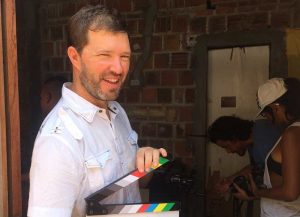Sentinels of Privilege and the Ressentiment of the Powerful
The New Right in Brazil
Rita de Cácia Oenning da Silva and Kurt Shaw
The idea for our documentary [1] was really quite simple. Children from a favela would make a short fictional film in which they showed how they imagined rich kids lived, while a group of children living in an upper-middle-class condominium made one about how they imagined life in the favela. We showed each film to the other group, and then brought the children together, first in the favela and then in the apartment building.
Our first shock came from Erik, a sharp and independent 11-year-old from the favela. ‘Those kids have everything: cell phones, toys, videogames… but I wish they had the freedom that we have, the freedom to go to the beach alone, to leap walls…’, and then a pause – ‘to make revolution’. Letícia, a girl from a middle-class family, described her apartment as a ‘prison in a cubicle in the sky’, and her friend João stunned us even more. ‘If I could change anything in my world… You know what isn’t fair? That favela kids can play in the street and we can’t. There should be equal rights for all!’
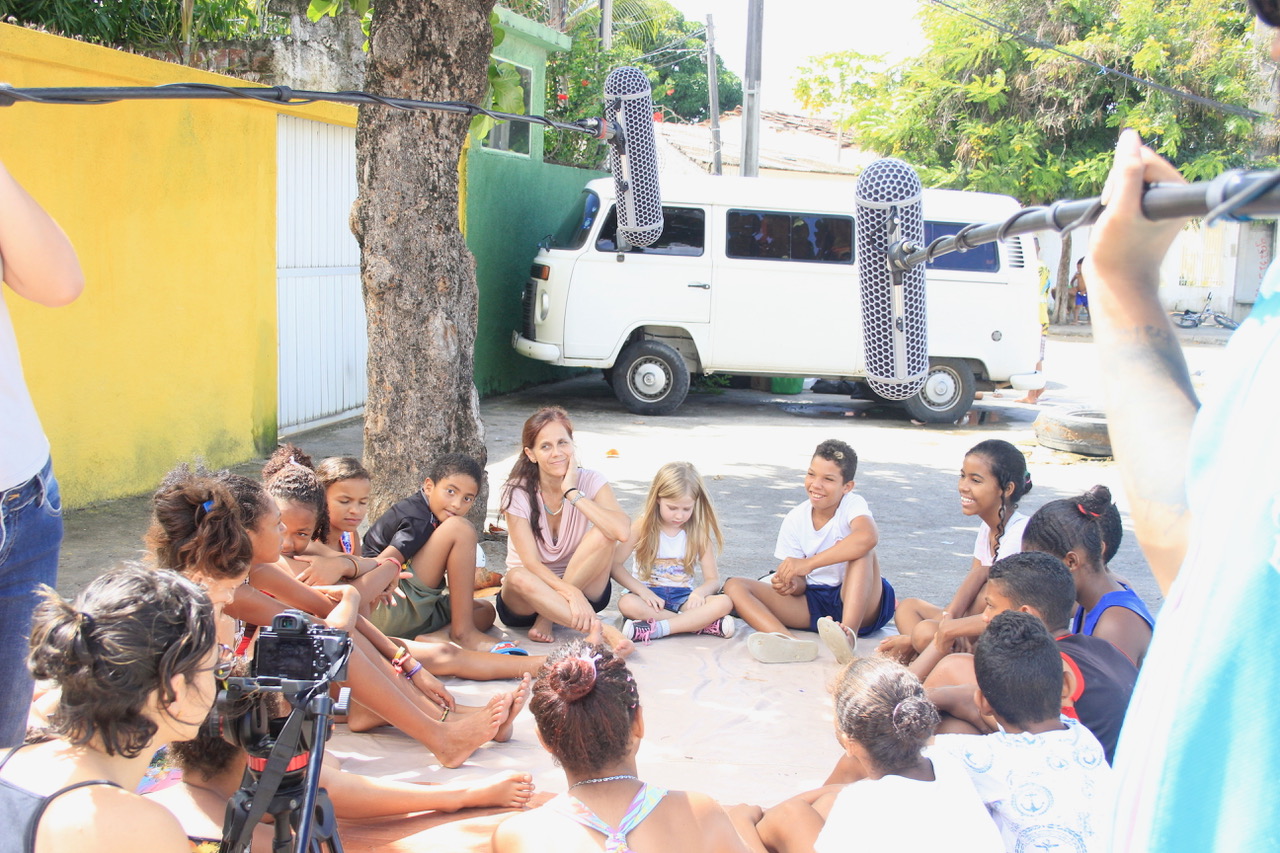
Children on both sides of these impenetrable walls of imagination, fear, and habit live contemporary Brazil in a particularly raw way, so their resentments, fears, and desires reveal unexpected insights into Brazil’s social apartheid, the new authoritarianism that has emerged to defend it, and possible ways to escape the vicious cycle of repression.
In this essay, we use ideas from children on both sides of the class wall in Brazil to examine two principal motivations for the new authoritarianism in Latin America’s largest country.
First, 15 years of government by the Workers’ Party (PT) had only begun to tackle Brazil’s social apartheid when new proto-fascist agents emerged to define themselves as the last defenders of the walls that kept the poor in their proper place. Children’s insights about possessions, privileges, and prestige show exactly why these sentinels of the Right so desperately needed to defend their privileges.
Second, João’s insight into unequal rights begins to show the way that resentment can corrupt an honest desire for freedom, turning it into the desire to repress those who seem freer.
Defending privileges
Authoritarian tendencies in Brazil are distinct from other countries where anti-democratic politics have recently become powerful. In 2016, using an anti-corruption campaign to empower the most corrupt politicians in the country, Brazil’s traditional elites staged a parliamentary coup d’état and quickly set about reversing the social and economic gains of the last 15 years.
Unlike Putin, Duterte, or Modi, however, the new president has no charisma and no real base of popular support. Rather, the New Right ideology was explicitly based on the fear of social mobility and the desire to preserve the traditional privileges of the elite, perhaps best understood as the walls around their hermetic world.
To understand this story, we have to begin from when these privileges became rooted. The Portuguese colonial power enslaved the ancestors of the children who now live in the favela and brought them across the Atlantic to work in the huge sugar plantations in what is now the state of Pernambuco. Slavery manifested itself in Brazil’s northeast in a particularly brutal form. Portugal was a small and underpopulated kingdom trying to control a huge realm: it could never develop the administrative controls of the French, British, or even Spanish empires.
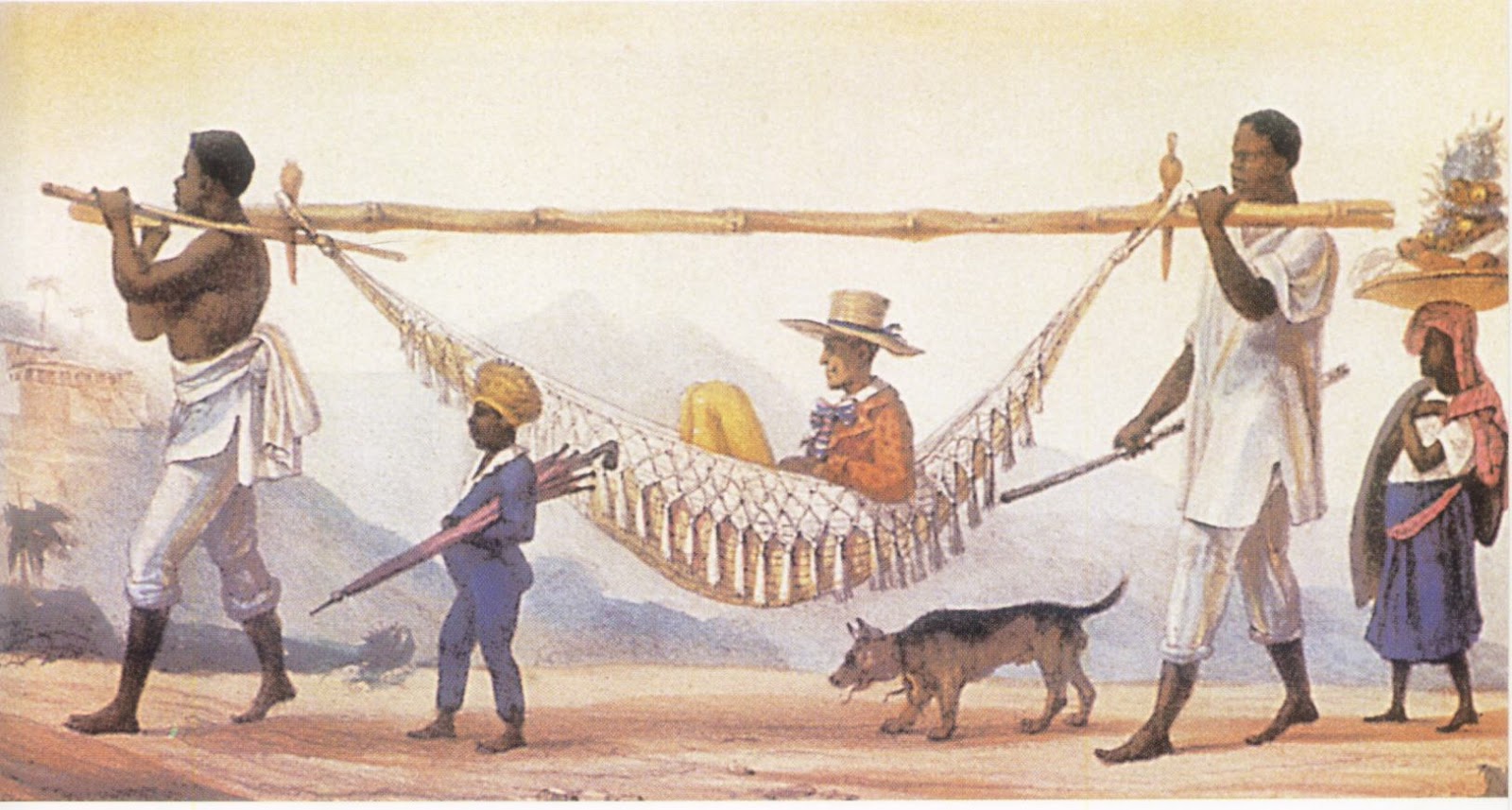
As a direct result, individual men won rights of exploitation from the king and then went into the remote areas of Brazil to carve out their own almost independent kingdoms. They owed formal fealty and some taxes to the king, but in day-to-day life they were masters of all they surveyed.
The church never developed as an independent force because the clergy and the churches in which they preached were bought and paid for by the colonial masters. As the sociologist and historian Jessé Souza puts it, ‘In Brazil, we are dealing with a limit concept of society’, an extension of mediaeval feudalism, but where the liege lord (the king) is so far away as to be effectively non-existent. [2]
Souza’s careful reading of Gilberto Freyre, a student of Franz Boas and eminence grise of Brazilian sociology, shows that this dynamic is essential in order to understand the country’s history and personality. An individual Portuguese man – sometimes with a Portuguese wife, but often not – had to populate, control, and exploit huge territories that had recently been devastated by the genocide of the indigenous peoples.
Freyre explored a new form of colonial administration and inheritance based on competition between the master’s legitimate and illegitimate children: with so many possible heirs, the master could base his decisions on obedience and who was best able to support his tantrums and authoritarianism.
‘That morbid delight at being evil with subordinates and with animals: it is so much ours, the inheritance of any Brazilian boy touched by the slaving system’,[3] Freyre wrote, recognising the sin even in himself. He went on to cite Bras Cubas, the great novel by Machado de Assis, where the narrator says that when he did something bad – torment the slaves for no good reason, play tricks on a visiting old woman – ‘my father would reprimand me in public as a pure formality, but when we were in private, he would kiss and congratulate me’.
Freyre sees sado-masochism as the principal legacy of slavery, a form of social relations in which the rich behave badly just to show that they can, just to show they can get away with it. [4] The total authority and impunity of the colonial lord continues as a fantasy of what some powerful Brazilians consider part of being recognised as powerful and important.
Geography serves as a broad means to understand this social distance: in colonial Brazil, the slaves inhabited the senzala, strictly cordoned off from the Casa Grande where the master and his family lived. Only a small cohort of trusted slaves would be allowed to serve in the Casa Grande and cross the border between the two worlds. As economic changes moved the descendants of slaves into the cities’ favelas, the relationship between condominiums and favelas came to mirror the old distinction between Casa Grande and senzala.

In order to bridge the world of slavery and impunity with the modern opposition between condominiums and favelas, we need to look at Brazil’s process of urbanisation in the nineteenth century. The sobrado, a sort of private urban fortress that enabled the rural elite to live and feel protected against these new threats, was now contrasted with the mucambo (improvised shack) where displaced blacks had come to live.
However, in a country where mixed-race people were able to obtain power through the new state bureaucracy and nascent industry (in which the old elites were largely uninterested), new definitions of power began to emerge. According to Jessé Souza, even the definition of race changed: ‘to be white was to be useful to the Europeanisation of the country’.[5]
Newly powerful families expressed their status through access to and the show of European commodities. Fashion became a basic tool of class formation: wearing clothes from London or Paris, drinking beer from Germany, and using the latest carriages and landaus became ways that the elite could show their superiority, regardless of their racial background.
To resist these fluid definitions of power, the traditional elite had to find new ways to exert control. In the mid-nineteenth century, gangs of upper-class youth roamed around Salvador and Rio de Janeiro, lynching blacks and mixed-race men and women who dared to use their new wealth to buy fashionable items. This movement, a kind of ‘fashion lynching’, would become the seed of social control for decades to come.
When an eight-year-old girl from the group of upper-middle-class children saw the film where children from the favela pretend to live in an exclusive apartment building, she said, ‘This is terrible, but the strangest thing was to see dark faces in an apartment. In my building, everyone is white. It shouldn’t be that way, but it is’. The use of ‘dark’ (moreno) rather than ‘black’ is telling, because although race is a simple shorthand for social difference in Brazil, the distinctions are much more complicated.
Black and white, favelado and elite are easy words, but being ‘moreno’ is based not only of having African or indigenous ancestors, but also of the amount of time spent working (and playing) in the sun. Years ago, one of our young friends from the favela spent two months in Europe on an exchange programme, and we and his mother waited for him at the airport. When he stepped out of the baggage area, his mother did not recognise him for several seconds. ‘I always thought we were black’, she laughed with us later, ‘but then I just realised that we’re always sunburnt’. A common Brazilian phrase illustrates this complex social construction of race: ‘Branco quase preto de tão pobre’ – white, but so poor they’re basically black.
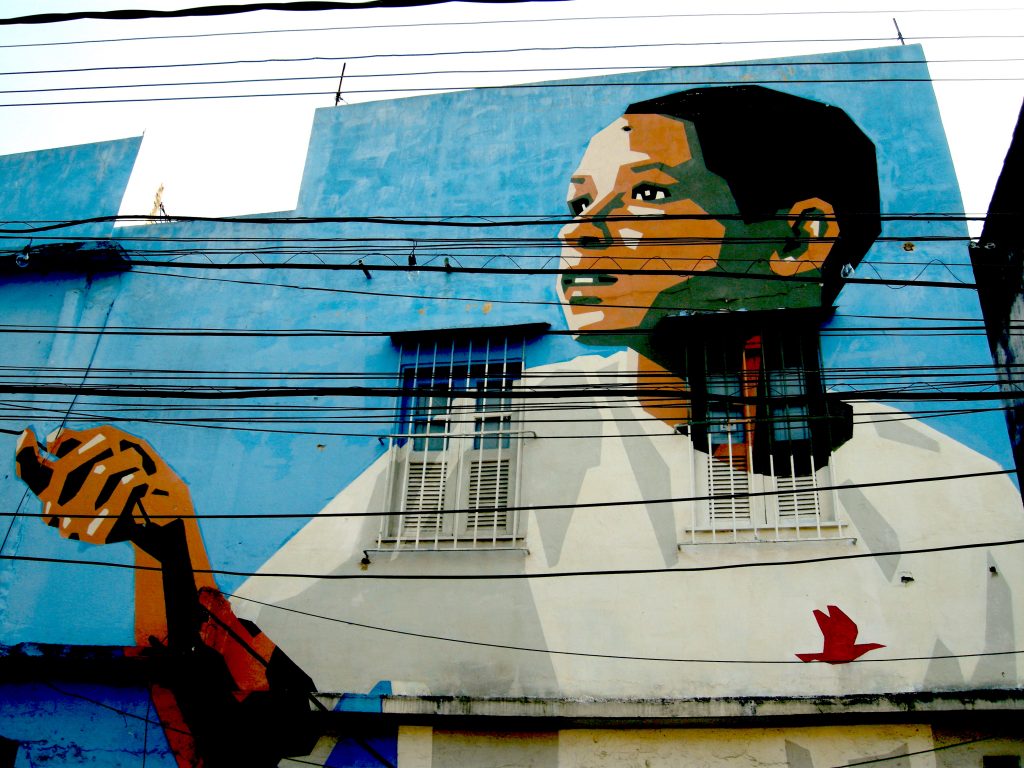
Even the architecture of modern Brazilian apartment buildings embodies this: a ‘social elevator’ leaves from the lobby to each front door, while a ‘service elevator’ will leave from the back of the building – often where the bins are kept – and go to a ‘service area’ in the home, the laundry and kitchen. As we filmed the documentary in the middle-class neighbourhood, at one point the camera assistant, a young man from the favela, found himself alone in the ‘social elevator’ with a resident of the building, who accused him of being a thief and demanded explanations from the film staff.
We were furious, but the young man took the affront as a completely normal, everyday humiliation. Recent architecture shows an even more glaring example of this segregation: in addition to separate elevators, some apartments now have separate kitchens, one for the day-to-day cooking done by the service staff, and another ‘social’ kitchen where the owners can cook to show off for their friends. Without race itself as a legitimate way to build social hierarchy, walls must be built of callouses, posture, vocabulary, and sunburn.
This brief historical survey helps us to understand the fundamental role of public universities in the 2016 coup. In the 1990s, an outsider might have seen Brazilian higher education as almost utopian: public universities were free, some were of excellent quality, and they offered a diverse menu of majors as pathways to the managerial and bureaucratic elite. A closer look at the student body, however, showed that almost all had attended private schools and came from the upper-middle class. In fact, the public university had become a lavish federal subsidy for the elite to reproduce itself.
Under the PT leadership (2002–2016), the Brazilian government funded an unprecedented expansion of public higher education. Equally importantly, it introduced an affirmative action policy in which half of the students accepted at public universities had to have studied in public high schools, and a smaller percentage from ethnic minorities.
Many observers believe that this policy served as one of the proxy causes of the 2016 coup d’état: with poor, black, and indigenous students gaining access to public universities and the civil service, the traditional upper-middle class realised that the superiority previously conferred by the state was under threat. As in the mid-nineteenth century, social mobility through the universities and business enterprises challenged fixed definitions of race and social status.
In response, gangs of upper-class young men began to threaten blacks, gays, and leftists within the universities, with alarming clashes registered on campuses across the country. The fashion lynchings of the nineteenth century had repeated themselves.
Radical members of the elite needed to repeat these forms of lynching to defend the walls of privilege because of the peculiar fluidity of race in Brazil: to repeat Souza’s perceptive comment, being white isn’t really about race, but about a person’s role in making the country seem more European.
Since the elite does not have the fixed rules of South African-style apartheid, they must control and limit access to the social capital of Europe or North America to ensure that blacks and poor people cannot play any part in this process of Europeanisation. For that reason, the university was such an important battlefield around the 2016 coup.
By way of illustration, Nicole, a charismatic 12-year-old from the favela, began her interview with us talking about a school friend. ‘They don’t let you go to school in sandals [often the only shoes that poor Brazilian kids own] and her family didn’t have the money for real shoes’. For Nicole, poverty is first and foremost about humiliation. School is one of the few rights conceded to poor children, but poverty is a wall that keeps even that state service from many kids.
As she spoke, we could see that she sees humiliation and money as part of a vicious feedback cycle: ‘We learned in school about gender and salary, and it turns out that women do the same job as men and get paid less. For the same work. In the same way, someone from the favela is paid a salary, but is it the same as rich people earn for the same work?’ Simply because people are from the favela, they will be paid less. Being paid less, they will be humiliated and have to live in the favela, and their children won’t have shoes to go to school. Again, children see control over fashion as a way to calcify or fix social status.
Though the greatest privilege of belonging to the Brazilian upper class is escaping the daily humiliations visited upon the poor, it also has a material element. Letícia, another of the girls from the middle-class group, told us about the van ride that took them from their leafy neighbourhood of high-rise apartments into the favela:
As we got closer to the favela, we saw more and more trash on the street. There were huge potholes in the road, and then there was barely a road at all. There were lakes where the water gathered after the rain. I started to think about that, and I realised how the government puts all this effort into my neighbourhood, and to places where tourists come, so it looks like we have a nice city. But they don’t seem to care at all about the favela.
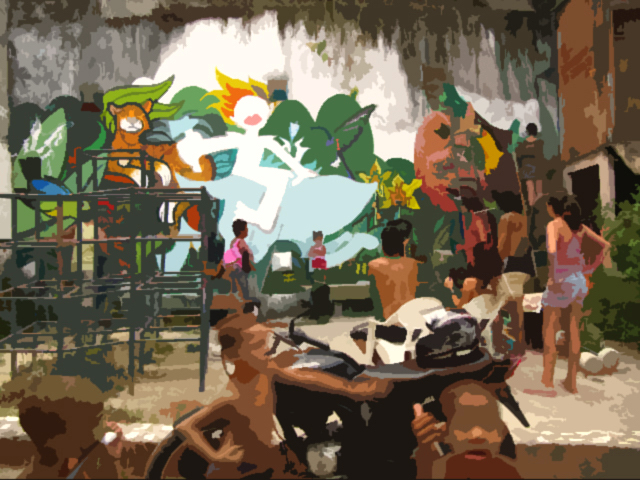
The question is not only the distribution of concrete benefits – which the state provides disproportionately to rich neighbourhoods – but also of recognition: as Letícia put it, the areas that tourists and rich people will visit. Brazilians have a pithy saying for the theatre of the symbolic: ‘Para inglês ver’ (For an Englishman to see).
We construct a kind of Potemkin reality to deceive the other, to make things seem better or more prestigious than they are, an idea very similar to Jacques Lacan’s concept that people try to deceive the Big Other as a way to deceive themselves. We must hide the senzala and the favela from the Englishman, so that we can pretend they do not exist.
What, then, is the dream of the Brazilian New Right? Its actions show two clear goals: first, to regain the impunity, authority, and other privileges of the rural feudal lords of the Casa Grande; and second, to recapture the honour and respect that they felt they had begun to lose in the 15 years of Workers’ Party government.
The ‘re’ in these goals explains the ‘new’ in the New Right: their goal is the re-conquest – and not simply the defence – of lost privileges.
Ressentiment of freedom
When João demanded equal rights to play in the street, he expressed his desire for freedom and his anger at his own gilded prison. He did so frankly and honestly. Later, he was elated to spend a day playing on the streets with his new friends from the favela. He eagerly shared his own life with these new friends, lending toys and showing them how to play with them.
Sadly, as middle-class teenagers and young adults become more socialised into the realities of Brazilian social apartheid, and as the fear of crime and contamination from the urban periphery inscribes itself on their bodies and shapes their instincts, their response may change.
A boy’s candid desire for freedom to play can become poisoned by what Nietzsche called ressentiment, the bitterness of feeling that others enjoy what we cannot. For Nietzsche, ressentiment corrupts desire: rather than sweating and striving for what we want, we long to prevent others from having it.
One of the main arguments of this essay is that important (and powerful) parts of the Brazilian polity have abandoned the struggle for freedom, preferring to live behind gilded walls. Instead of striving for freedom, they have come to resent – and as such, want to oppress – those who they think have it. When João’s insight about equal rights is expressed directly, it becomes an opportunity for play, encounter, and liberation. When it ferments into ressentiment, it gives rise to a new form of Latin American fascism.
When we wanted to understand the defence of privilege, we turned to Gilberto Freyre’s Casa Grande e Senzala, but to understand ressentiment, we needed its sequel, Sobrados e Mucambos. [6] Here, Freyre analyses the path of the rural elites of the Casa Grande after the Portuguese Empire moved its capital to Rio de Janeiro in 1808. With the need to gain favours from the court, access to trade routes, and participation in national and international markets, the families that had long enjoyed total power in their fazendas now had to come to Rio de Janeiro, where they became subject to the laws of the state, the fashions of the court, and the demands of the nascent market.
Though they continued to hold slaves, they no longer enjoyed complete impunity of action, and in fact, they imprisoned themselves in the sobrados in order to guarantee their safety in an unstable, dangerous, and ‘filthy’ city. Like the inhabitants of modern gated condominiums, they sacrificed their freedom for security and then began to resent a poor class they believed to be freer than themselves. Their sons went on to commit the fashion lynchings that became an unconscious model for the new Right.
To this point, we have referred to the ‘the elite’ largely as a way to refer not to any individual person or group, but rather to the collective interests of groups that have for centuries controlled Brazilian politics and economics. We now need to be more specific, because there is a difference between class interests, conscious beliefs, and what individual people and collectives actually do. We discuss of the vanguard of Brazilian fascism: young men who believe that they serve as the shock troops to defend good morals, capitalism, and the traditional family. These are the inheritors of the fashion-lynching gangs of the mid-1800s, seeing themselves fighting the dangerous new fluidity in power and money.
This is not to suggest that most middle-class, conservative, or even elite Brazilians agree with these perspectives, merely that their interests benefit from the actions of this small, vocal, and violent minority. Similarly, in the 1920s, it would have been unjust to tar conservative and business-minded Germans as the allies of the Freicorps; nonetheless, as the decade rolled on, the conservative establishment first became the beneficiaries of Freicorps’ action and then their allies in Nazism.
Journalists [7] who have investigated the Brazilian equivalent of the alt-right (as elsewhere, a variegated collection of true believers, social misfits, trolls, and angry (young) men) identify certain important beliefs and attitudes.
- A love of militaristic phrases, violent images, and provocative memes
- Misogyny, homophobia, and xenophobia
- Expressions of nausea and disgust at the poor
- Idolatry of certain (white, male, violent) authority figures
- Advocacy of torture, violence, and extra-judicial killings
- A sense that they are the victims of a great left-wing conspiracy
A quick look at Facebook or WhatsApp groups where these young men gather explains our reference to the Weimar period and the earlier fashion lynchings: we see exactly the same attitudes as in in Klaus Theweleit’s extraordinary history of the Freicorps. [8]
Like the German proto-fascists, these young men see themselves as victims of an unjust new world, as the true representatives of their nation and tradition, and as the bulwark against the filth of enemy social groups. Indeed, if one replaces ‘juden’ with ‘favelado’, the slogans are remarkably similar.
We see another important parallel between the Brazilian alt-right and the new fascism in the United States, as seen in Charlottesville, for example, and among the most virulent supporters of Donald Trump: since they see themselves both as victims of a new world and as protecting civilisation against the filth of the poor, they have the right – the freedom – to realise their violent fantasies.
Increasingly, groups of young men who claim to follow the radical right-wing congressman Jair Bolsonaro have invaded universities to beat up students, gays, and beneficiaries of affirmative action. During both pro- and anti-coup street protests, they infiltrated the marches as vandals and provocateurs.
Perhaps most importantly, there are very close links between these alt-right youth and the militias who control the drug trafficking and black markets in many favelas. They also revel in the right of the police to use violence with impunity: we see this on a daily basis in our work in the favela, but also felt it shortly after the coup in the pounding hooves of mounted police that tried to run us and our six-year-old daughter down during a peaceful street protest.
The rhetoric of these groups is fascinating, because while they condemn gang violence in the favela, they clearly envy it. They demand that the police, the militias, and they themselves should have the same ‘carta branca’ (carte blanche) as the gangs to use violence and torture. They rejoice in their violent language.
Bolsonaro is lauded because ‘he says what he really thinks, he isn’t afraid to be a bad guy’. In this rhetoric, the constraints of civilisation on young men – don’t kill, torture, and exploit others – stimulate ressentiment, because they believe that young black men have more freedom than they do.
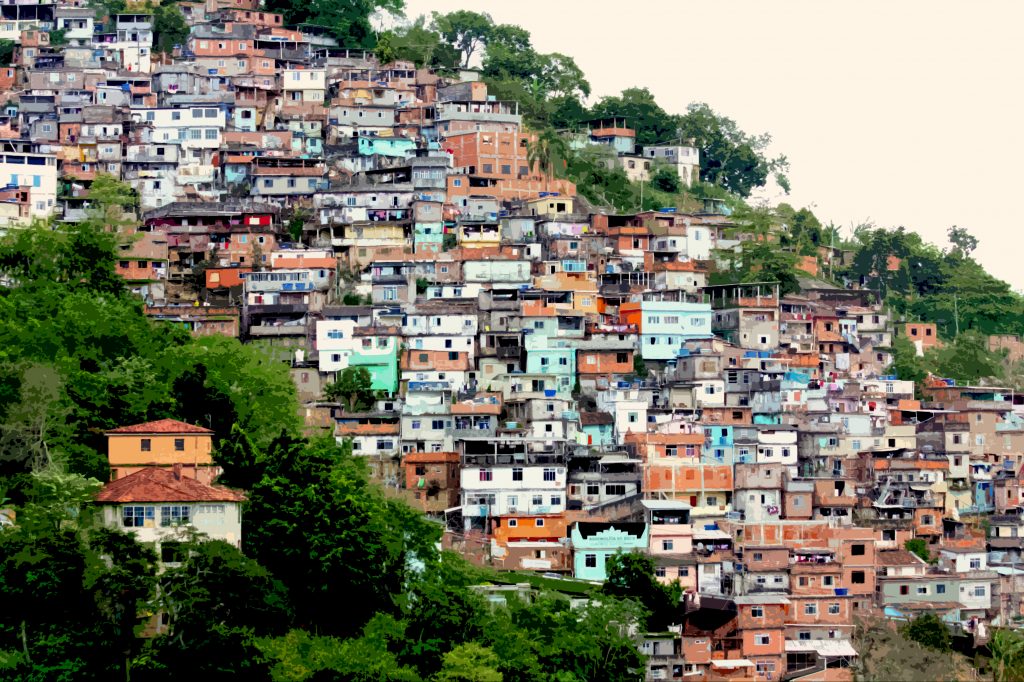
To understand the power of this discourse, we need to look at how militias have taken over organised crime in many large Brazilian cities. Starting in the 1950s, Brazil urbanised rapidly in both middle-class neighbourhoods and in the favelas.
Urbanisation and social change brought with them a demand for illicit drugs, as they did in the United States and Europe. Since the favelas did not even exist on city maps, had no public services, and were largely out of bounds to the police, they became a free-trade zone for commodities that were illegal in the rest of the economy. By the 1980s, the gangs controlling drug trafficking in Rio de Janeiro and many other Brazilian cities were so powerful that that they could challenge the police militarily.
In our study of drug trafficking in Recife, we found a fascinating commercial structure. While the original supplier and most of the consumers came from rich neighbourhoods, the physical commerce – as well as the intermediaries who exchanged drugs for money – took place in the favela. Rich men, often with political connections, would import drugs and then sell them to crack-houses in the favela; dealers there would sell cocaine and marijuana largely to people from outside the favela, while diverting some sales to internal use. Police officers were bribed to turn a blind eye. [9]
The militias, which began to emerge in the late 1990s or early 2000s in Rio de Janeiro and then spread to many other large cities in the country, can be understood as a way to cut out the intermediary. Rather than accepting bribes to ignore trafficking, off-duty police and private security officers began to take over the business.
For the international dealers, this meant subcontracting drug sales with the police instead of with gangs from the favela; they continued to make good profits. For people in the favela, the drug war became even worse, because the new business model cut off their minimal contact with the powerful gangs that controlled their communities. Instead of gang leaders they had known from childhood, they were ruled by outsiders who charged protection money and waged occasional war against other militias and gangs, all with the protection of the police and often the government. [10]
This brief diversion is important to our argument both because of how it has changed life in the favela, and also because of the way that militias are understood in Brazil. The tabloids portray the militias as saviours in the struggle for law and order. Local Pentecostal churches often ally themselves with the militias as a form of social control. Politicians eagerly and openly seek the support of militia leaders during ‘get out the vote’ drives. The alt-right sees these militias and middle-class self-defence gangs as a new form of freedom and masculinity, perhaps even as a way to realise the fantasy of impunity of the lord of the feudal Casa Grande.
Most middle-class Brazilians would flinch from the language used by militias and the alt-right –rants for enforced sterilisation of Muslims, immigrants, and the poor; accolades for torturers from the military dictatorship; peons to fascism. At the same time the militias and alt-right have become both very effective guards of tradition and an expression of the social unconscious and its ressentiment of the supposed freedom of the favela.
Though as yet small in number and limited in actions, they strike fear into poor and black people who seek to break down the walls between social classes in Brazil, or who merely hope for state recognition and equal rights.
New strategies
For real hints of hope in resisting Brazil’s new authoritarianism, we must look at a much broader portrait of contemporary social movements. Sadly, developments over the last 30 years have weakened the traditional pillars of the Brazilian progressive Left: the globalised economy has undermined trade unionism, the Vatican and neo-Pentecostal groups have all but destroyed Liberation Theology, and powerful financial interests have invested in transforming higher education into mere job training.
New forms of resistance have, however, emerged as a way to combat the Brazilian New Right and its roots in ressentiment and the defence of privilege.
Perhaps the most interesting and unexpected movement in contemporary Brazil has been of students taking over high schools. In response to corruption, shrinking budgets, and the elimination of sociology, history, philosophy, literature, physical education, and several other ‘subversive’ subjects from the national secondary curriculum, students around the country began to take over their schools.
After closing the doors to the authorities, one student would teach maths to her peers, another would teach history, and others would organise study and mentoring groups. Many used school kitchens to cook their own food, audio-visual equipment to create YouTube or Facebook news channels, and art supplies to repaint their classrooms. Often, sympathetic teachers would help, but the students locked out administrators and bureaucrats. Though police invasions and eventually the summer holiday ended many of these experiments, at one point students had seized more than 1000 schools around the country.
Afro-Brazilian history, culture, and religion have long served as a resource for the Brazilian Left, from the syncretism between candomblé and Liberation Theology to the use of drums, dance, and theatre in social movements. Over the last 20 years, a nexus of intolerant evangelicals, drug gangs, and politically connected militias has begun to repress Afro-Brazilian religion ever more openly; finally, in 2016 the right-wing evangelical Marcelo Crivella became the mayor of Rio de Janeiro and began to use state power to support this violence.
In early 2018, militias and police officers became sufficiently emboldened to assassinate the Afro-Brazilian city councillor Marielle Franco. In response, the previously fractured Afro-Brazilian religious community has unified in large and small-scale protests and self-defence forces, and has allied with capoeiristas, the hip-hop movement, and the favela-rights movement.
One of the most important developments in contemporary Brazil is the rapprochement among previously fragmented groups dedicated to re-thinking gender. Academic and middle-class feminists have begun to join with black women from the favelas – Marielle Franco was an excellent illustration of this synthesis before her assassination – sometimes around explicit political goals but often around cultural groups like escolas de samba, maracatus and rodas de capoeira.
The Landless Peasants Movement (MST), first founded to demand agricultural reform as a part of the leftist revolutionary ferment of the 1960s and 1970s, is one of the few traditional progressive organisations to persist into the second decade of the twentieth century. During the lead-up to the coup d’état in 2016, it was able to mobilise more activists than anyone on the streets, and its use of theatre and music continues to inspire urban youth as well as rural landless workers.
The Temer government has taken agro-business and the concentration of land tenure as central goals of its administration, so the continued use of direct action by the MST – occupying and planting unused land, providing markets for small farmers, giving legal support to people forced from their land – is essential to maintaining the small gains in land distribution achieved over the last decade. The ‘Roofless Movement’ of urban squatters and homeless people inspired by the MST joined them as an essential part of the current social movement, but political and judicial persecution has hampered their effectiveness over the last year.
Many of the attempts to concentrate land tenure in the hands of agro-business and mining interests – especially companies owned by or friendly to members of Temer’s cabinet – create conflict with indigenous peoples.
In several cases, cabinet members have been exposed as running para-military death squads that force indigenous groups from their land and murder leaders who refuse to move; according to the Inter American Commission on Human Rights, more than 700 indigenous and environmental leaders have been killed in Brazil over the last 15 years, and the numbers have increased since the coup d’état. Indigenous activism continues to be an important part of resistance to authoritarianism in Brazil: not so much in pure numbers, but in the dramatic image of their feathers, bows, and blow-guns in front of the capitol in Brasília.
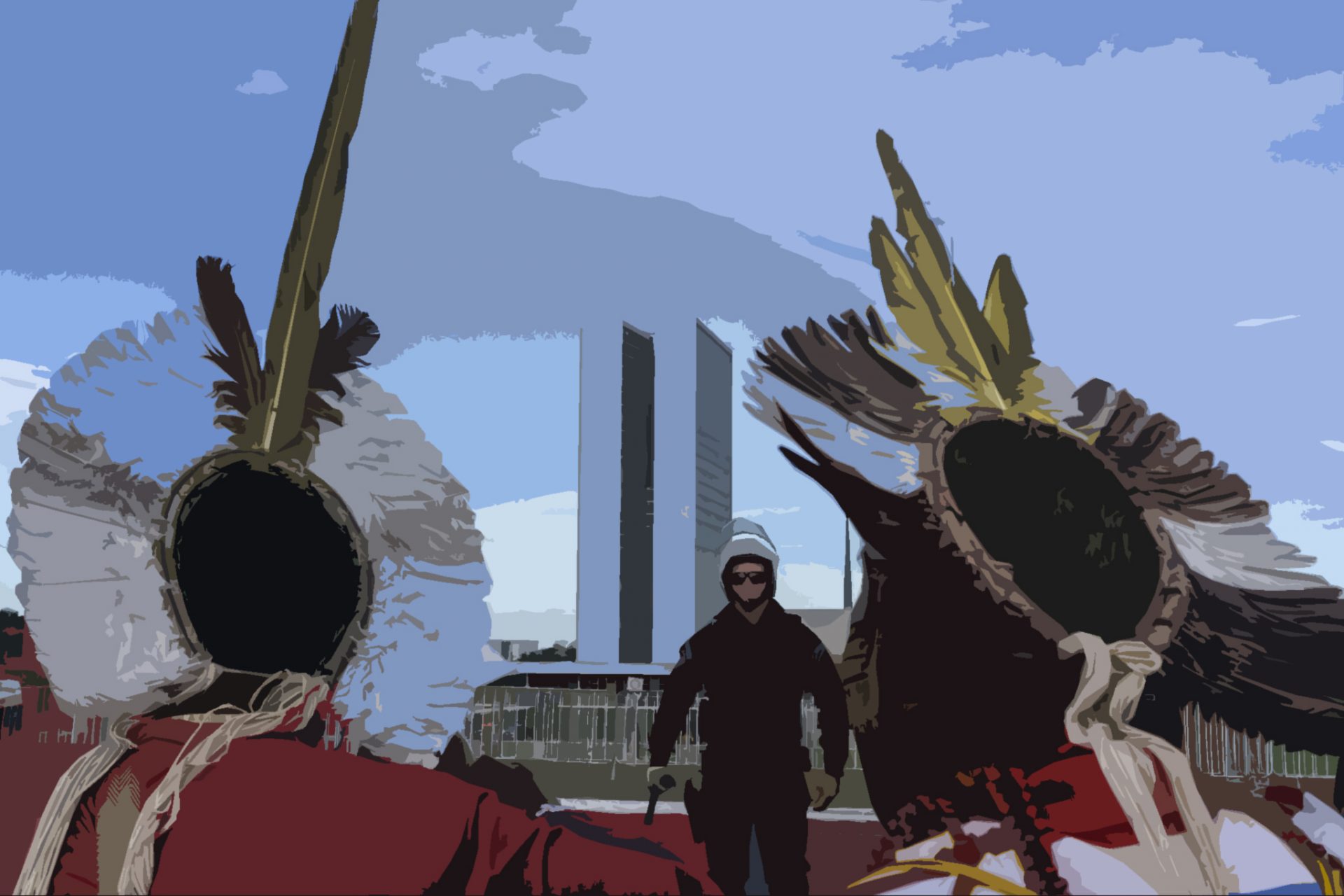
Anger at the coup has also created interesting resistance movements, starting with large protests during the votes for impeachment in both houses of Congress and continuing through ‘Occupy the Culture Ministry’, where artists took over local government offices for weeks on end with constant concerts, poetry readings, and theatre performances – finally succeeding in preventing Temer from eliminating funding for culture.
At the time of writing in April 2018, this opposition to the coup has taken up a new banner: after ex-president Lula was given a prison sentence based on incomplete and often falsified evidence, he refused initially to be taken to jail. Close to 20,000 people surrounded him in the centre of São Bernardo do Campo before he eventually turned himself in.
Finally, community media has become an important point of resistance to the New Right… and, perhaps more importantly, a way to undermine the social dynamics we have diagnosed in this essay as the causes and justifications of authoritarianism. In the context we have described, how do we learn about the ‘other’? Through ideologically biased media. The rich learn about the poor through the pornographic ‘true-crime’ shows that infest afternoon TV.
The poor learn about the rich through telenovelas. The Left learns about the Right and vice versa through one-sided, self-serving polemics on Facebook or partisan blogs, or through self-re-enforcing feedback loops on WhatsApp. The ‘other’ is made more distant and monstrous, further justifying the fascist, paramilitary guards at the wall, as well as the fantasies and ressentiment that each group has of the other.
The best FavelaNews movie made by kids
As a response to a gang war in two favelas of Recife where we had long worked, in 2012 we created FavelaNews, an internet-based news channel that aimed to subvert the conflict in various ways. FavelaNews addressed the economy of prestige, the way that recognition and fame, understood as scarce resources, are distributed through young men in the favela.
Previously, young men felt that they could only gain recognition through violence: as one teenager put it, ‘when you put a gun to the head of a rich old woman, she knows you exist’. We suggested that even at a minor level, the internet makes it possible to develop new resources to build and maintain prestige. With three to five stories a week showing the simple and good things that happen in the favela – old men who sing in a bar, girls who teach other children to play marbles, skilled street vendors or performers – FavelaNews rewards different social actors and shows young people new ways to seek the previously scarce resource of recognition.
It has become a new mirror through which young people in the favela can see themselves, an alternative to the conveyor belt that took ambitious children exclusively into the gangs. In combination with constant street parties that would bring together people from previously warring favelas and a campaign for police reform, we managed to bring homicide rates down from 600/100,000 to less than 10.
To a large extent, the film we described in the beginning of this essay is an extension of these efforts: an attempt to use cinema and play as non-threatening ways to drill holes in impenetrable and well-guarded walls. In the same way that the gangs along the Canal do Arruda didn’t see an occasional break-dancer or soccer player from the other side as a threat, even the most fascistic defenders of the barrier between rich and poor have a soft spot for kids.
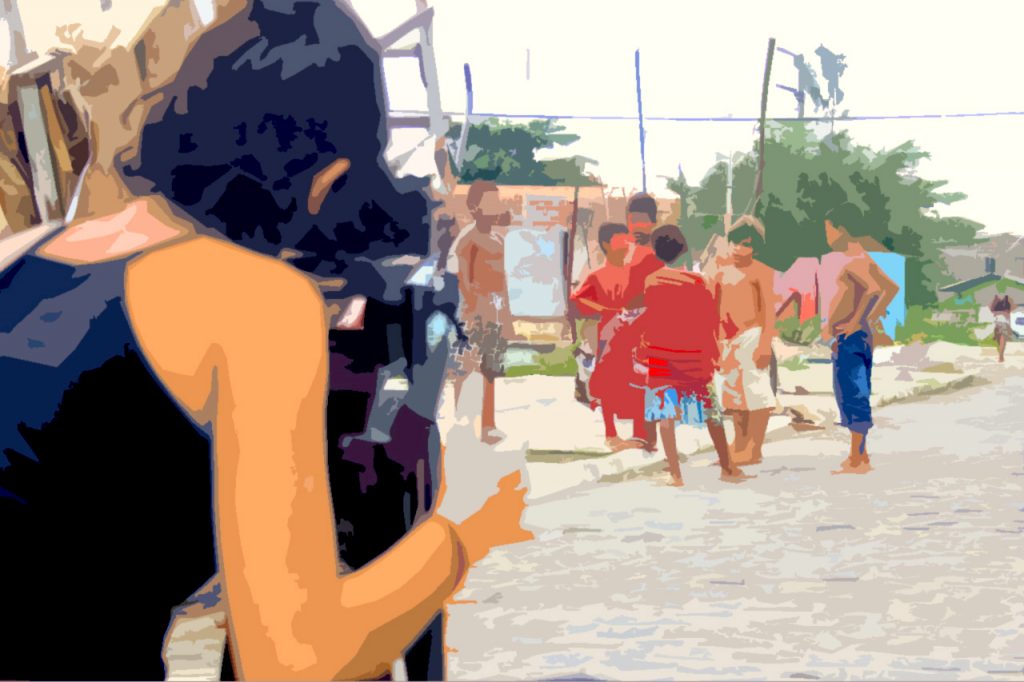
The good-hearted parents who let their children participate in the documentary were excited that they could learn about the other side of the divide and that Brazilian public television – even under an authoritarian government – financed and will broadcast the experiment. As kids from rich neighbourhoods play in the favela, they learn the complexities of the space: they can enjoy their right to play on the street (undermining ressentiment) at the same time as sympathising with poor black kids when police throw them up against a wall for a brutal daily frisking.
During the encounter that serves as a climax to our documentary, Letícia – from the middle class – spent much of her time talking with Kauane, a girl from the favela. Later, Letícia told us, ‘When we were talking, she told me that last night, after our group left the favela and came home, the police invaded the favela. They humiliated the girls, frisked them. The police break down the doors of the houses. You know, they don’t do that in our apartment building’, she continued in amazement, almost tears. ‘They don’t.’
Most middle-class children see the police as an ally, keeping them safe from the bandits and thieves they see on TV and hear about in hushed adult conversations. Many parents see the alt-right militias and the paramilitaries as a necessary evil, a way to keep the chaos and crime of the favela at bay. That legitimacy, however, fell apart for Letícia and many of the others who participated in the documentary. For them, ‘the other’ in the favela will never again be a simple monster. In the realm of the imaginary, we had scored a small victory against the legitimisation of the New Right.
FavelaNews is only one of dozens of small-scale media alternatives that have emerged in favelas around Brazil over the last five years, all making their own small impact. At the national level, alternative media sources like Mídia Ninja and Brasil 247 have given many of these local collectives a voice and an opportunity to create a counter-narrative to the official story told on commercial TV, although they have yet to reach beyond ‘preaching to the choir’.
None of these kinds of action are a solution to the new Brazilian authoritarianism, nor does this essay even hope to be a complete analysis of the way that the right has been able to take over the Brazilian state and economy so quickly and mercilessly. We have not been able to address the role of the judiciary as an agent force for authoritarianism, taking on the legitimating role played by the armed forced in the 1960s and 1970s. However, we can present this reflection as a step, the hint of a strategy, and a kind of cairn on the trail to forms of resistance against the new authoritarianism in Latin America’s largest country.

